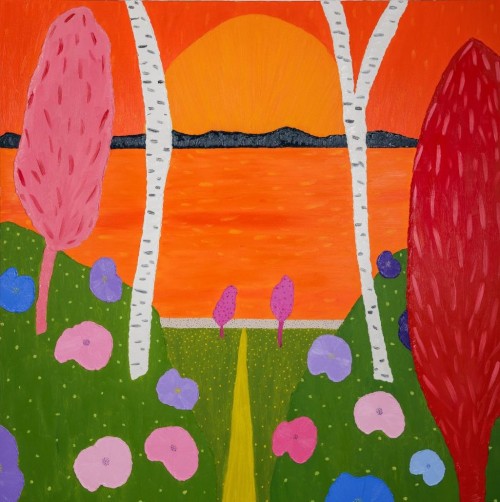
Gates of Paradise: James Goss
The Pit is pleased to present Gates of Paradise a solo exhibition of new works by New York based artist James Goss, his second solo exhibition with the gallery. The exhibition will be one of the lasts in The Pit’s original Glendale space in Los Angeles and will be on view from September 23 - October 28, 2023. An opening reception will be held on Saturday September 23 from 5-7pm with the artist present.
Ever since James Goss was a child, he looked at things very closely, blades of grass, flowers, paintings. The feeling of first staring into the center of a blossom, seeing a whole new world inside, or discovering the elaborate map of ridges and furrows on the underside of a leaf, is familiar, if not ubiquitous. Perhaps what makes Goss unique is that he never stopped looking, never allowed his sense of wonder and awe in the face of nature’s mundane miracles to lessen. A habit that’s evidenced by the subject, scope, and scale of the eight paintings in Gates of Paradise. “If I pay close enough attention and stay open, a conversation starts between nature and myself,” says Goss. “I become a sort of channel.”
Goss, who’s lived and worked in the Adirondacks for the last forty years, considers taking his boat out onto nearby Lake Champlain and tending to his robust home garden just as much a part of his artistic practice as moving oils around a stretched canvas. Only once he’s spent enough time outdoors watching and absorbing do the images, emotions, and colors appear to him, ready to be transposed in paint. Rather than trying to faithfully capture each petal within one of his zinnias or blades of grass in the surrounding meadows, Goss paints the experience of close looking, not the close looking itself. The resulting technicolor dreamscapes, full of flowers large as stars, lakes flushed in rose-colored light, and dissolving horizons that collapse the boundaries between water and sky, push, similarly to Georgia O’Keefe, against the limits of realism. Each hue, brushstroke, and composition, charged with energy and vitality, contribute to an overwhelming sense of elation bordering on euphoria.
That a mountain or a tree is not only incomprehensibly complex but also strikingly simple is highlighted throughout the show. Emphasizing the primary geometric shapes that appear over and over in both geological and biological forms. Biomorphic circles, ovals, triangles, stripes, and stars are used to depict islands, lakes, flowers, and trees. No matter the time of day or season, the eternal forms remain consistent in each scene. “It’s a universal language,” explained Goss, “a mountain is a teaming microcosm of innumerable species, but it’s also an enormous triangle; I mean, a horizon is but a line! Everyone can understand that.”
In forgoing photorealist representations, the artist relies on the materiality of his paint to depict detail. Goss sculpts, scrapes, layers, and manipulates enormous amounts of oil to emulate the crenelation of a flower petal, the lushness of a patch of grass, and the grit of a sandy beach. To see the ridges and grooves on the trunks of the elm trees is to feel their scaley bark beneath your palm in an inspired moment of synesthesia. The densely built-up paint on the canvas also produces a quasi-bas-relief, with the objects in the foreground appearing to rise out of the canvas, as in The Beginning, where the elm trees are not only visually but physically the closest figures to the viewer, animating an uncanny sense of linear depth.
The supersaturated color palette is largely responsible for the work’s surrealist qualities. Mixing his own hues, Goss prioritizes vibrancy and intensity above all else, hoping to reproduce the naturally occurring luminosity he witnesses daily. Though he avoids entirely monochromatic schemas, a single hue often dominates each landscape, not unlike the way sunlight envelops and transforms everything it touches. In Evening at Lincoln Pond, blues range from midnight to cobalt to cerulean, mimicking the sky’s transition from day to night. In Early Spring Light and New Life, variations of peony pink unify water, earth, and atmosphere. Throughout the exhibition, color is used to enact and interrogate symmetry and repetition, further emphasizing the fluidity of forms, the illusion of boundaries, and the gestalt experience of nature’s beauty.
—Tara Anne Dalbow